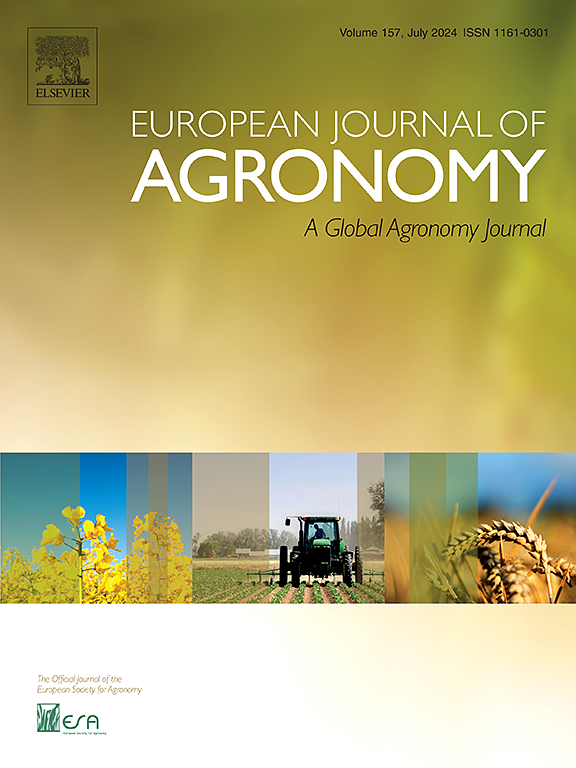利用太阳诱导叶绿素荧光和高光谱反射率对小麦白粉病进行早期诊断
IF 4.5
1区 农林科学
Q1 AGRONOMY
引用次数: 0
摘要
白粉病威胁着全世界的小麦生产,早期检测对控制病害、最大限度地提高产量和质量具有重要意义。为了提高小麦白粉病的早期遥感检测能力,利用三波段弗劳恩霍夫线判别(3FLD)和反射率指数方法提取了太阳诱导叶绿素荧光(SIF)参数,并通过高光谱反射率计算了植被指数(VI)。不同数据源的所有特征和特征子集都被用作多元线性回归(MLR)、随机森林(RF)和支持向量机(SVM)算法的输入,以构建小麦白粉病监测模型。SVM 包括线性核函数(LK)、多项式核函数(PK)和高斯径向基函数(RBF)。在小麦白粉病胁迫下,小麦冠层反射率出现蓝移,荧光减弱。在使用 3FLD 方法提取的 O2-A 波段中,SIF-A 强度与病害指数(DI)的相关性最高,为-0.781,表明 SIF 参数有助于监测白粉病。无论是基于所有特征还是基于特征子集,RBF 模型的准确率都是最高的,其次是 RF 和 MLR。在特征子集中,RBF、LK 和 PK 模型的准确度范围分别为 0.740-0.871、0.724-0.850 和 0.716-0.841。RBF 模型中的 SIF+VI 更适用于小麦白粉病的早期和稳定病害监测。这一创新技术方案有望支持小麦白粉病的早期诊断,显著提高病害防控效率和效果。本文章由计算机程序翻译,如有差异,请以英文原文为准。
Early diagnosis of wheat powdery mildew using solar-induced chlorophyll fluorescence and hyperspectral reflectance
Powdery mildew disease threatens wheat production worldwide, and early detection is of great significance for disease control and maximizing yield and quality. To improve early remote sensing detection of wheat powdery mildew, solar-induced chlorophyll fluorescence (SIF) parameters were extracted using three-band Fraunhofer line discrimination (3FLD) and reflectance index approaches, and vegetation index (VI) was calculated by hyperspectral reflectance. All features and feature subsets of different data sources were used as inputs to multiple linear regression (MLR), random forest (RF), and support vector machine (SVM) algorithms to construct a wheat powdery mildew monitoring model. SVM includes linear kernel function (LK), polynomial kernel function (PK), and Gaussian radial basis function (RBF). Under wheat powdery mildew stress, wheat canopy reflectance showed a blue shift, and fluorescence weakened. The correlation between SIF−A intensity and disease index (DI) in the O2−A band extracted using the 3FLD method was the highest at −0.781, showing that the SIF parameter was useful for monitoring powdery mildew. Whether based on all features or feature subsets, the RBF model achieved the highest model accuracy, followed by the RF and the MLR. In the feature subset, the accuracy ranges of RBF, LK, and PK models are 0.740−0.871, 0.724−0.850, and 0.716−0.841 respectively. The SIF+VI in the RBF model is more useful for early and stable disease monitoring of wheat powdery mildew. This innovative technical solution is expected to support the early diagnosis of wheat powdery mildew, significantly improving disease prevention and control efficiency and effectiveness.
求助全文
通过发布文献求助,成功后即可免费获取论文全文。
去求助
来源期刊

European Journal of Agronomy
农林科学-农艺学
CiteScore
8.30
自引率
7.70%
发文量
187
审稿时长
4.5 months
期刊介绍:
The European Journal of Agronomy, the official journal of the European Society for Agronomy, publishes original research papers reporting experimental and theoretical contributions to field-based agronomy and crop science. The journal will consider research at the field level for agricultural, horticultural and tree crops, that uses comprehensive and explanatory approaches. The EJA covers the following topics:
crop physiology
crop production and management including irrigation, fertilization and soil management
agroclimatology and modelling
plant-soil relationships
crop quality and post-harvest physiology
farming and cropping systems
agroecosystems and the environment
crop-weed interactions and management
organic farming
horticultural crops
papers from the European Society for Agronomy bi-annual meetings
In determining the suitability of submitted articles for publication, particular scrutiny is placed on the degree of novelty and significance of the research and the extent to which it adds to existing knowledge in agronomy.
 求助内容:
求助内容: 应助结果提醒方式:
应助结果提醒方式:


